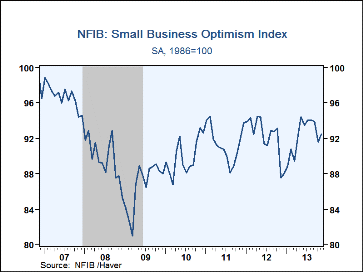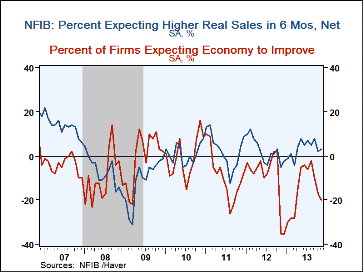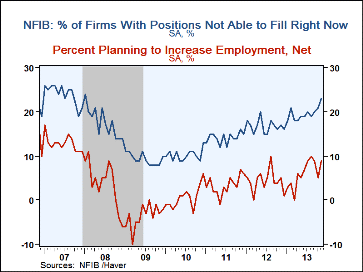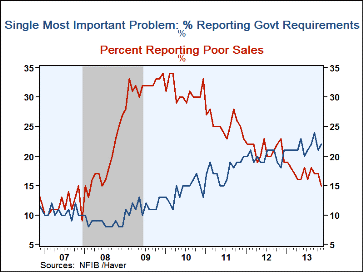 Global| Dec 10 2013
Global| Dec 10 2013U.S. Small Businesses Lack Enthusiasm Near Yearend
by:Tom Moeller
|in:Economy in Brief
Summary
The National Federation of Independent Business reported that its Small Business Optimism Index rose to 92.5 during November. That recouped, however, just a piece of its sharp October decline to an unrevised 91.6. The latest figure [...]
The National Federation of Independent Business reported that its Small Business Optimism Index rose to 92.5 during November. That recouped, however, just a piece of its sharp October decline to an unrevised 91.6. The latest figure remained down sharply from the May high of 94.4.
Cautious optimism ruled the report. Just 3% expected higher real sales in six months, nearly the least since March. The percentage of firms expecting the economy to improve fell to -20%, its least since March. Suggesting that labor market conditions remained tight, a much higher 23 percent of firms had positions they were not able to fill right now, the most since before the recession. An increased 9% were planning to increase employment but a higher 44% of firms found few or no qualified applicants for job openings, also the most since before the recession.
A lessened 2% of firms were raising average selling prices, but an improved 19% planned to do so in the future. A greatly increased 14% planned to increase worker compensation, the most since April 2008.
The most important problems faced by small business were government requirements (22%), taxes (21%), poor sales (15%), insurance cost & availability (11%), competition from large businesses (8%), quality of labor (8%), cost of labor (5%), inflation (4%) and financial & interest rates (2%).
Roughly 24 million small businesses exist in the U.S. and they create 80% of all new jobs. The typical NFIB member employs 10 people and reports gross sales of about $500,000 a year. The NFIB figures can be found in Haver's SURVEYS database.
| National Federation of Independent Business | Nov | Oct | Sep | Nov'12 | 2012 | 2011 | 2010 |
|---|---|---|---|---|---|---|---|
| Small Business Optimism Index (SA, 1986=100) | 92.5 | 91.6 | 93.9 | 87.5 | 92.2 | 91.4 | 89.9 |
| Firms Expecting Higher Real Sales In Six Months (Net %) | 3 | 2 | 8 | -5 | 2 | 3 | 1 |
| Firms Expecting Economy To Improve (Net %) | -20 | -17 | -10 | -35 | -9 | -9 | -1 |
| Firms Planning to Increase Employment (Net %) | 9 | 5 | 9 | 5 | 4 | 3 | 1 |
| Firms With Few or No Qualified Applicants For Job Openings (Net %) | 44 | 40 | 41 | 36 | 35 | 32 | 27 |
| Firms Reporting That Credit Was Harder To Get (Net %) | 6 | 6 | 5 | 9 | 8 | 10 | 13 |
| Firms Raising Avg. Selling Prices (Net %) | 2 | 5 | 1 | 0 | 4 | 5 | -12 |
Tom Moeller
AuthorMore in Author Profile »Prior to joining Haver Analytics in 2000, Mr. Moeller worked as the Economist at Chancellor Capital Management from 1985 to 1999. There, he developed comprehensive economic forecasts and interpreted economic data for equity and fixed income portfolio managers. Also at Chancellor, Mr. Moeller worked as an equity analyst and was responsible for researching and rating companies in the economically sensitive automobile and housing industries for investment in Chancellor’s equity portfolio. Prior to joining Chancellor, Mr. Moeller was an Economist at Citibank from 1979 to 1984. He also analyzed pricing behavior in the metals industry for the Council on Wage and Price Stability in Washington, D.C. In 1999, Mr. Moeller received the award for most accurate forecast from the Forecasters' Club of New York. From 1990 to 1992 he was President of the New York Association for Business Economists. Mr. Moeller earned an M.B.A. in Finance from Fordham University, where he graduated in 1987. He holds a Bachelor of Arts in Economics from George Washington University.










